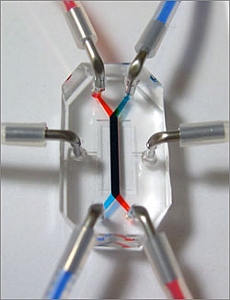Biomedical engineers at Harvard University have created a miniature electronic device with living human cells that mimics the structure, physiology, and mechanics of the human intestine. The team from Harvard’s Wyss Institute for Biologically Inspired Engineering published its findings online in the journal Lab on a Chip (paid subscription required).
The team led by Wyss Institute founder Donald Ingber developed the “gut-on-a-chip” (pictured left) as a silicon polymer device about the size of a computer flash memory stick. The chip could provide researchers investigating intestinal conditions such as Crohn’s disease and ulcerative colitis with an alternative to conventional cell cultures and testing on animals.
The device has complex 3D features of the intestine in a miniaturized form. A central chamber has a layer of human intestinal epithelial cells growing on a porous membrane substrate that recreates the intestinal barrier. The flexible membrane attaches to side walls that stretch and recoil with the aid of an attached vacuum controller.
This cyclic mechanical action resembles the wave-like motions that move food through the digestive tract. The device also recreates a form of the intestinal tissue-to-tissue interface, which allows fluids to flow above and below the intestinal cell layer. This action mimics the micro-environment on one side of the device and the flow of blood through capillary vessels on the other side. The researchers that include Wyss Institute fellows Hyun Jung Kim, Dan Huh, and Geraldine Hamilton were also able to grow common microbes on the surface of the cultured cells to simulate some of the physiological features important to understanding intestinal diseases.
The chip’s features make it a potential lab tool for diagnosing the cause and progression of intestinal disorders that can help develop new therapies and probiotics. The gut-on-a-chip could also test in the lab metabolism and oral absorption of drugs and nutrients.
Ingber believes the device represents an improvement over current animal-testing methods. “Because the models most often available to us today do not recapitulate human disease,” says Ingber, “we can’t fully understand the mechanisms behind many intestinal disorders, which means that the drugs and therapies we validate in animal models often fail to be effective when tested in humans.”
Read more:
- Simple Microfluidics Immune System Sensor Developed
- Pump Designed for Lab-on-a-Chip Medical Diagnostics
* * *


 RSS - Posts
RSS - Posts
You must be logged in to post a comment.